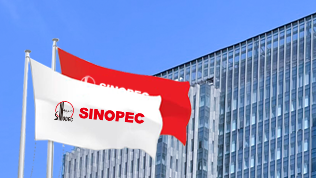Technological Innovation and IT Application
In recent years, the Sinopec Group closely followed the development strategy of “resources, market, integration and globalization”, the principle of “six unifications” (unified planning, unified standard, unified design, unified investment, unified construction and unified management), and the policy of “combining building and utilization with focus going to utilization”. The Group vigorously pushed IT application with EPR at its core. The IT application in the headquarter was apparently improved so that all the relevant functional departments started regularly using EPR as their operation and management platform as well as production operation controlling platform; the building and application of key information systems including concentrated capital management system and business information sharing system has achieved obvious effects; the innovation capacity of software with independent IPR was constantly increased; and the IT application in the Group’s subsidiaries was further deepened. Among the IT application level competition organized by SASAC, the Group was evaluated as class-A enterprise, holding the first place. Meanwhile, three of the Sinopec’s IT application projects including ERP system, production and operation controlling system and e-commerce system were evaluated as demonstrative IT application projects. The deepened IT application within Sinopec played critical roles in pushing corporate management innovation, reducing corporate cost and increasing efficiency, and raising the corporate core competitiveness.
|
The steadily pushed EPR application in the Group further raised the scientific management capacity of production and operation. The subsidiaries whose financial statements need to be directly consolidated to that of the Sinopec Corp. saw the completion of their EPR system; new progress was achieved in data base building; concentrated accounting calculation system were smoothly pushed in the Group. By the end of 2009, EPR system was on line in 89 subsidiaries, covering upper steam, middle stream, down stream subsidiaries of the Sinopec Corp. Meanwhile, the EPR applications in both headquarter and subsidiaries were improved further through a comprehensive campaign of “EPR application year” in headquarter. ERP applications started to be integrated in the routine job of all the departments in headquarter with the initial effects being achieved. ERP application in subsidiaries was pushed into new stage, and the subsidiaries made attempts in meeting the relevant targets and establishing themselves as examples for their counterparts. By the end of 2009, 68 subsidiaries reached ERP application standard. The core production and operation business of the subsidiaries were managed in a standardized way through ERP system and the system’s controlling function in planning, capital, supplier, clients were given full play. New breakthroughs were made in the centralized capital management system and business information sharing system and new effects were achieved in their application. The initiation of centralized capital management system led to unified and centralized management of the Groups capital. In 2009, the number of transactions with external entities conducted through the capital management system reached 35,000 so that the balance of domestic capital was reduced by a large margin and the capital utilization efficiency was raised greatly. The key business information and its database management was made transparent through the key business information sharing system, including the information of general procurement, self sales of refined products, chemical products sales, oil products sales, external procurement, and engineering construction so that the production and operation management becomes more open and transparent. The comprehensive budget management system for refining subsidiaries were completed, which led to the possibility of the headquarter departments and subsidiaries to supervise and inquiry on production and operation data, the full collecting of the data of analytical statement of all the headquarter departments, the increasing of timeliness and accuracy of the analysis, and the apparently increasing of the refined management and budget management capacity. New progress was also made in public website building. The group’s website was evaluated as class A in the company website competition among the central SOEs affiliated to SASAC. The Group’s platform for production and operation was further enhanced which brought new looks for the production management of both headquarter and subsidiaries. Production and operation controlling system in Headquarter has become a unified platform for headquarter to direct its production and operation, which led to the concentrated adjustment and unified controlling of the headquarter’s production and operation business. The application of the system achieved good economic returns in optimizing structure, increasing the total output, supervising the oil price, adjusting the stock, optimizing the transportation, and reducing tanker demurrage. The application of supply chain system continued to be deepened. The Headquarter used PIMS model to join online its quarterly and annual production and operation plan with those of its subsidiaries, which led to the increased efficiency and standardized production plan management. The completion of XPIMS model building of the refining and chemical subsidiaries enabled the company to optimize the procurement of crude oil and raw material, so as to mutually supplied materials could be arranged reasonably between refining and chemical business. Fuel card system was improved greatly so that its consumption function could be applied in convenience store and the promotion of its use in convenience store was completed. The comprehensively pushed IT application in the subsidiaries achieved obvious effects in management improvement, cost reduction and efficiency increase, as well as market expansion. The data base building of oilfield subsidiaries’ exploration and development business was pushed steadily and the optimization of production system achieved initial effects. The system of data collecting at the source was comprehensively applied in oilfield subsidiaries like Shengli, Jianghan, Henan and so on, which basically realized the standardized data collecting at the source and data’s shared application. The completion of pilot data center in Shengli oilfield led to the building of data center management mechanism at subsidiary-level. Sound result was gained in the pilot optimized production system of collection, transportation and water flooding and obvious effects were also achieved in energy saving and emission reduction. New progress was made in the improvement and application of software with oilfield subsidiaries’ independent IPR. The Group successfully convened the second independent IPR software communication conference, which identified the soft-wares to be collected into the Sinopec oilfield subsidiaries’ independent IPR software products category. The deepened building and application of the refining subsidiaries’ production execution system provided accurate, timely feedstock information and production process information for the production and operation of the refining subsidiaries. The smooth operation of APC system made great contribution to the energy saving and consumption reduction of the facility, and the raising of productivity and product quality. The steadily pushed application of LIMS system raised the automatic management level of the subsidiaries’ laboratory. The application of steam pipe network operation management and intelligent supervision system supports the energy saving and consumption reduction of the steam pipe network of the subsidiaries. Initial effects were achieved in the application of comprehensive analysis and decision system in refining subsidiaries so that the subsidiaries could closely follow the relevant links of the production process by integrating the data from ERP, MES and real data base, which provided a good reference for the company to optimize its plan. The sales subsidiaries completed the execution of the retail electric accounting book management project, and standardized the retail business process, management, data and financial statement management at various levels, so that they achieved the collecting of all the service station management and operation data in one time and data sharing among multiple systems, which provides a effective tool for the retail management supervision and analysis. The electric lading bill program was applied in all the branches at provincial and municipal levels and this program won the third prize of Sinopec’s Science and Technology Progress Award. |
|
In recent years, the Sinopec Group closely followed the development strategy of “resources, market, integration and globalization”, the principle of “six unifications” (unified planning, unified standard, unified design, unified investment, unified construction and unified management), and the policy of “combining building and utilization with focus going to utilization”. The Group vigorously pushed IT application with EPR at its core. The IT application in the headquarter was apparently improved so that all the relevant functional departments started regularly using EPR as their operation and management platform as well as production operation controlling platform; the building and application of key information systems including concentrated capital management system and business information sharing system has achieved obvious effects; the innovation capacity of software with independent IPR was constantly increased; and the IT application in the Group’s subsidiaries was further deepened. Among the IT application level competition organized by SASAC, the Group was evaluated as class-A enterprise, holding the first place. Meanwhile, three of the Sinopec’s IT application projects including ERP system, production and operation controlling system and e-commerce system were evaluated as demonstrative IT application projects. The deepened IT application within Sinopec played critical roles in pushing corporate management innovation, reducing corporate cost and increasing efficiency, and raising the corporate core competitiveness. The steadily pushed EPR application in the Group further raised the scientific management capacity of production and operation. The subsidiaries whose financial statements need to be directly consolidated to that of the Sinopec Corp. saw the completion of their EPR system; new progress was achieved in data base building; concentrated accounting calculation system were smoothly pushed in the Group. By the end of 2009, EPR system was on line in 89 subsidiaries, covering upper steam, middle stream, down stream subsidiaries of the Sinopec Corp. Meanwhile, the EPR applications in both headquarter and subsidiaries were improved further through a comprehensive campaign of “EPR application year” in headquarter. ERP applications started to be integrated in the routine job of all the departments in headquarter with the initial effects being achieved. ERP application in subsidiaries was pushed into new stage, and the subsidiaries made attempts in meeting the relevant targets and establishing themselves as examples for their counterparts. By the end of 2009, 68 subsidiaries reached ERP application standard. The core production and operation business of the subsidiaries were managed in a standardized way through ERP system and the system’s controlling function in planning, capital, supplier, clients were given full play. New breakthroughs were made in the centralized capital management system and business information sharing system and new effects were achieved in their application. The initiation of centralized capital management system led to unified and centralized management of the Groups capital. In 2009, the number of transactions with external entities conducted through the capital management system reached 35,000 so that the balance of domestic capital was reduced by a large margin and the capital utilization efficiency was raised greatly. The key business information and its database management was made transparent through the key business information sharing system, including the information of general procurement, self sales of refined products, chemical products sales, oil products sales, external procurement, and engineering construction so that the production and operation management becomes more open and transparent. The comprehensive budget management system for refining subsidiaries were completed, which led to the possibility of the headquarter departments and subsidiaries to supervise and inquiry on production and operation data, the full collecting of the data of analytical statement of all the headquarter departments, the increasing of timeliness and accuracy of the analysis, and the apparently increasing of the refined management and budget management capacity. New progress was also made in public website building. The group’s website was evaluated as class A in the company website competition among the central SOEs affiliated to SASAC. The Group’s platform for production and operation was further enhanced which brought new looks for the production management of both headquarter and subsidiaries. Production and operation controlling system in Headquarter has become a unified platform for headquarter to direct its production and operation, which led to the concentrated adjustment and unified controlling of the headquarter’s production and operation business. The application of the system achieved good economic returns in optimizing structure, increasing the total output, supervising the oil price, adjusting the stock, optimizing the transportation, and reducing tanker demurrage. The application of supply chain system continued to be deepened. The Headquarter used PIMS model to join online its quarterly and annual production and operation plan with those of its subsidiaries, which led to the increased efficiency and standardized production plan management. The completion of XPIMS model building of the refining and chemical subsidiaries enabled the company to optimize the procurement of crude oil and raw material, so as to mutually supplied materials could be arranged reasonably between refining and chemical business. Fuel card system was improved greatly so that its consumption function could be applied in convenience store and the promotion of its use in convenience store was completed. The comprehensively pushed IT application in the subsidiaries achieved obvious effects in management improvement, cost reduction and efficiency increase, as well as market expansion. The data base building of oilfield subsidiaries’ exploration and development business was pushed steadily and the optimization of production system achieved initial effects. The system of data collecting at the source was comprehensively applied in oilfield subsidiaries like Shengli, Jianghan, Henan and so on, which basically realized the standardized data collecting at the source and data’s shared application. The completion of pilot data center in Shengli oilfield led to the building of data center management mechanism at subsidiary-level. Sound result was gained in the pilot optimized production system of collection, transportation and water flooding and obvious effects were also achieved in energy saving and emission reduction. New progress was made in the improvement and application of software with oilfield subsidiaries’ independent IPR. The Group successfully convened the second independent IPR software communication conference, which identified the soft-wares to be collected into the Sinopec oilfield subsidiaries’ independent IPR software products category. The deepened building and application of the refining subsidiaries’ production execution system provided accurate, timely feedstock information and production process information for the production and operation of the refining subsidiaries. The smooth operation of APC system made great contribution to the energy saving and consumption reduction of the facility, and the raising of productivity and product quality. The steadily pushed application of LIMS system raised the automatic management level of the subsidiaries’ laboratory. The application of steam pipe network operation management and intelligent supervision system supports the energy saving and consumption reduction of the steam pipe network of the subsidiaries. Initial effects were achieved in the application of comprehensive analysis and decision system in refining subsidiaries so that the subsidiaries could closely follow the relevant links of the production process by integrating the data from ERP, MES and real data base, which provided a good reference for the company to optimize its plan. The sales subsidiaries completed the execution of the retail electric accounting book management project, and standardized the retail business process, management, data and financial statement management at various levels, so that they achieved the collecting of all the service station management and operation data in one time and data sharing among multiple systems, which provides a effective tool for the retail management supervision and analysis. The electric lading bill program was applied in all the branches at provincial and municipal levels and this program won the third prize of Sinopec’s Science and Technology Progress Award. |

Contact Us
 Address
Address- 22 Chaoyangmen North Street, Chaoyang District, Beijing, China
 Post code
Post code- 100728
 Tel
Tel- 86(0)10 59960114
Legal Notice
This Website is constructed by China Petrochemical Corporation. (hereinafter referred to as SINOPEC). Please read carefully the following terms...
LEARN MORE






 京公网安备11010502035639
京公网安备11010502035639